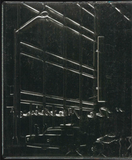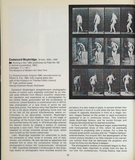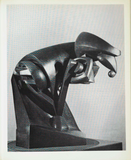The story of how artists of this century have looked upon and interpreted machines in attitudes ranging from devotion and even idolatry to deepest pessimism and despair is the subject of an exhibition of more than 200 works of art and related objects on view at The Museum of Modern Art from November 27 through February 9, 1968.
The Machine as Seen at the End of the Mechanical Age was directed by K. G, Pontus HultSn, Director of Moderna Museet, Stockholm, who is also the author of the accompanying catalog bound in tin-can steel*. Since the beginning of the mechanical age, some people have looked to machines to bring about progress toward Utopia; others have feared them as the enemies of humanistic values, leading only to destruction, Mr. Hultfin observes. Most of these contradictory ideas persist, in one form or another, in the 20th century and find their reflection in art. This is evidenced in the exhibition in the works of art varying in character from the conventional mediums of painting, sculpture, drawings, prints, photographs and films to motorized constructions and computer graphics.
Also included are two kinds of functional mechanisms - the automobile and the camera. Many works enlist the participation of the spectator, such as Jean Tinguely's Metamatic No. 8, an art-producing machine with which visitors can make their own watercolors, and his Rotozaza, which ridicules the practical side of the producing machine and the economics of overproduction by eating up its own output - balls - when the visitor tosses them back into the machine. Other works selected include paintings of speeding automobiles by the Futurists, Duchamp's The Bride, described as a well-oiled machine running on "love gasoline," and Picabia's mocking machine portraits. The influential model of I920 for a Monument for the Third International by the Russian Constructivist Tatlin has been reconstructed in the Museum Garden. The Dadaists' ironic and frequently poetic use of machine forms, Klee's early foreshadowing of the Surrealist fear of machines in the Twittering Machine, Giacometti's The Captured Hand, and Moholy-Nagy's Light Space Modulator for the Bauhaus are among the works gathered for the exhibition as well as examples of Lfiger's romantic attitude to the machine and the Purists' interest in the superficial beauty of machine form.
First Edition Catalogue. Very Good Condition.



































